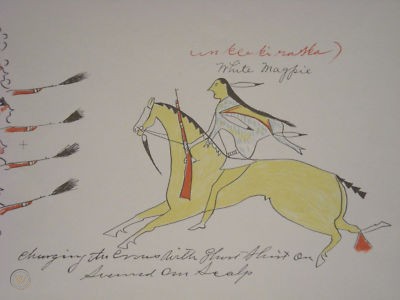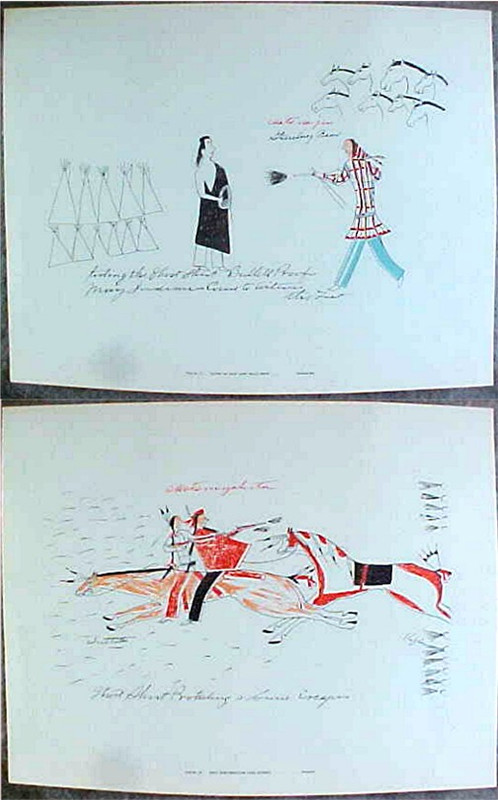|
|
Post by nicolas (carlo) on Jan 21, 2013 11:45:09 GMT -5
Does anyone know the significance of the red capes Lakota warriors often wore during battle? I used to assume it was personal preference, but have since seen examples of many different individuals wearing one, which leads me to believe it has some sort of special significance. Sometimes it's worn together with a distinctive red hat.
It said Crazy Horse also wore one during battle, and we know White Bull, Jaw, High Backbone, Circling Hawk, and many others did.
I have not seen it included in any descriptions of warrior society regalia, so it must be something different. Badge of a war leader or leading warrior, perhaps?
Note: I don't mean the warrior society red "stake sashes".
Thanks,
Carlo
|
|
|
|
Post by nicolas (carlo) on Jan 25, 2013 3:20:26 GMT -5
|
|
|
|
Post by nicolas (carlo) on Jan 29, 2013 15:47:47 GMT -5
Educated guesses are welcome as well...!
|
|
|
|
Post by hreinn on Jan 6, 2015 14:30:35 GMT -5
An influence/tradition from the Cheyennes ?
Based on the 1783 entry in Makula's winter count:
"A man with a red blanket was killed in a battle, a Cheyenne."
This entry implies that the red blankets/capes have a relatively long tradition.
|
|
|
|
Post by dT on Jan 7, 2015 14:41:10 GMT -5
Interesting question.
I didn't know that Crazy Horse did that. I wonder if he did it commonly -
the red blanket? My impression of Crazy Horse is that he was very practical
in battle, and a skilled warrior. I doubt that he carried a "lot" of unnecessary
stuff. Yes, he did have certain religious (ceremonial) items that were very
important to him. But they were not bulky - nothing that slowed him down.
Maybe the red blankets signified some sort of attainment ... e.g. it was a status symbol for
warriors who had killed a certain number of enemies in battle?
Otherwise, I cant think of any possible advantage to them.
dT
|
|
|
|
Post by gregor on Jan 9, 2015 5:50:22 GMT -5
I don't know if red blankets had a special significance for Lakota warriors in a battle. I've never read or heard anything about this. But I doubt it because such a cloak would be rather cumbersome in a rider attack. Of course blankets were used to irritate the horses of attacking enemies and to scare them away.
The color red, of course, had a special significance for Lakotas. E.g. a "red blanket" was indeed a metaphor for a blood sacrifice. In the context of war red symbolized also blood, strength, energy, power and success in war.
Trade Cloth blankets (in red or blue) were also much valued Merchandise.
And there is one event when red blankets were very appreciated: In connection with burials. The deceased was often wrapped in a red blanket, if available.
Gregor
|
|
|
|
Post by nicolas (carlo) on Jan 10, 2015 2:11:30 GMT -5
It is actually a well documented fact that red capes were indeed worn often in battle, please see my original posts. I have since concluded that the cape, often in connection with a hat or turband of sorts, was a badge of a leading warrior, one that others would watch to do important deeds in battle.
Also please note that an attribute being "impractical" or "cumbersome" in our eyes never refrained plains warriors from carrying or wearing it in battle. Long trailing war bonnets are just one of many such examples. And I would not qualify a short cape (see visuals in the links; it was not a blanket!) as such anyway.
Carlo
|
|
|
|
Post by grahamew on Jan 10, 2015 6:45:19 GMT -5
Do you mean very specifically the type worn by the man at the right of this picture - which seems to be the same kind of combination worn by High Backbone in the Bad Heart Bull drawings (unfortunately, I couldn't find an example of this on the internet)?  |
|
|
|
Post by shan on Jan 10, 2015 9:54:17 GMT -5
Hi grahamew,
I've often wondered about these red capes myself. They do indeed look cumbersome, but then so do the warbonnets. There are in fact a quite number of examples of men wearing these in the Bad Heart Bull drawings of the battle of the L.B.H. In fact we see this type of garment in a good many other ledger art drawings as well.
One thing to take into consideration, whereas many of the contempories of the men we see depicted in various ledger drawings would have recognised the men in question by the clothing they're wearing, generally speaking we can't. Having said that, I would hazard a guess that the red cape must have denoted something important about the man wearing it. These warriors rarely wore something that didn't have some significance, or else serve as some kind of visual signal to both friends and enemies alike.
From what we know of the battle of the L.B.H, I'd hazard a guess that very few warriors had the time to be able to dress up for battle in the way they would have liked, so what we see in the Bad Heart Bull drawings is how they would have wished to be seen, rather than how they probably looked on the day.
Sorry grahamew, I can't resist a P.S. I don't suppose you've had any more luck manipulating that group photo of Low Dog; the one in which we see a small white boy lying in the foreground in front of the group have you? I continue to scan the various sites in the hope that a better resolution of that image might appear, but no luck so far.
Shan
|
|
|
|
Post by gregor on Jan 10, 2015 11:20:04 GMT -5
I am quite willing to get disabused (I hope its the right expression). When I wrote "I have never read or heard anything about these capes", I meant statements of Black Elk, Ricker, Wissler, etc. But maybe I easy read it over. I once again went through my Bad Heart Bull copy of "Pictographic History of the Oglala". Bad Heart Bull drew in fact, some warriors with capes (I'd estimate 2 out of 20 people carry a cape or even a checkered blanket (Pic. No. 143) in war scenes. It is obvious that some of the cape carriers have a Thunderbird on the mantle - Heyokas? Or perhaps the cloaks designate blotahunkas? Next to some cloak carriers BHB also passed on names: Crazy Horse (No. 295), High Back Bone (No. 254) or Young Skunk (No. 160). Against that guess speaks that Jack Red Cloud - who was in the Rosebud fight - is also depicted with a cape (No. 105-110).
BHB also records the paraphernalia of the various warrior societies (Cante Tinza, Wiciska, Miwatani, Sotka Yuha, Iroka, Kangi Yuha, Tokala / Pics 22 - 30). No picture shows some kind of a cloak.
I'm curious what this discussion will unearthen furthermore.
Greetings from Germany
Gregor
|
|
|
|
Post by kingsleybray on Jan 10, 2015 11:35:08 GMT -5
I don't know if this is relevant, but Clark Wissler's monograph on Oglala societies (p. 96) mentions that members of the Horse Cult had "no special regalia, except that they usually used a piece of flannel on the head." Colour not specified but must be either red or dark blue.
|
|
|
|
Post by allenc on Jan 10, 2015 12:02:37 GMT -5
I have noted war capes of various designs and colors, not just the solid red, in ledger drawings. A couple of examples are attached, along with possible examples of war capes from the AMNH and Smithsonian. Drawings from NAA-SIRIS. Hope this comes through. Almont  |
|
|
|
Post by grahamew on Jan 10, 2015 15:26:47 GMT -5
I don't have it in front of me, but I'm pretty sure designs like this are covered in Wissler's Some Protective Designs of the Lakota - as if images once used on shields were employed on skins or blankets and invested with the same sort of protective powers. In the Red Hawk ledger drawings, there are a number referring to testing the ghost shirt (though ghost shirts are nowhere to be seen), though the drawings seem to depict events long before 1890.    However, one drawing features a man in a red cape and turban/headdress combination like High Backbone and the man in my last post. Again, it's referred to as a ghost shirt, so if we can generalise, it seems to be implying that these garments offered some sort of mystical protection in battle. |
|
|
|
Post by nicolas (carlo) on Jan 10, 2015 15:49:10 GMT -5
Do you mean very specifically the type worn by the man at the right of this picture - which seems to be the same kind of combination worn by High Backbone in the Bad Heart Bull drawings (unfortunately, I couldn't find an example of this on the internet)? Yes Grahame, that is the type I'm referring to. The red cape was not always, but often, worn together with the red turban/hat. I do believe these to be different than the capes painted with protective designs as depicted in the top two visuals of your last post; these are more personal to the individual warrior and thus more akin to what whites invariably called "ghost shirts" or variations thereof. From what I have seen, the red war capes did not have any markings or drawings on them, except for a white border at the bottom sometimes. Great that the thread is finally alive btw! |
|
|
|
Post by hreinn on Jan 10, 2015 17:03:09 GMT -5
I was wondering if the turbans were an influence from the Siouan speaking Dhegihan nations Ponca and Osage ?
Part of Ponca/Osage mixed with Lakotas and formed the Lakota Wazhazha and Ashke bands and were also taken into Wacheunpa-Kiyuksa group.
In old photos, we can see some of the males of Ponca and Osage nations wearing turbans.
|
|